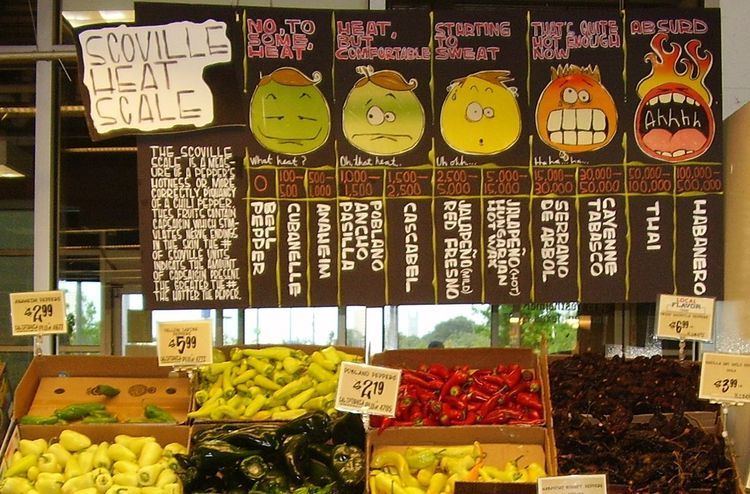 | ||
The Scoville scale is a measurement of the pungency (spicy heat) of chili peppers—such as the jalapeño, the bhut jolokia, and the world's current hottest pepper, the Carolina Reaper—or other spicy foods as reported in Scoville heat units (SHU), a function of capsaicin concentration. Capsaicin is one of many related chemicals, collectively called capsaicinoids. The scale is named after its creator, American pharmacist Wilbur Scoville. His method, devised in 1912, is known as the Scoville Organoleptic Test.
Contents
Unlike methods based on high-performance liquid chromatography, the Scoville scale is a subjective measurement dependent on the capsaicin sensitivity of testers and so is not a precise or accurate method to measure capsaicinoid concentration.
Scoville organoleptic test
In Scoville's method, an exact weight of dried pepper is dissolved in alcohol to extract the heat components (capsaicinoids), then diluted in a solution of sugar water. Decreasing concentrations of the extracted capsinoids are given to a panel of five trained tasters, until a majority (at least three) can no longer detect the heat in a dilution. The heat level is based on this dilution, rated in multiples of 100 SHU.
A weakness of the Scoville Organoleptic Test is its imprecision due to human subjectivity, depending on the taster's palate and their number of mouth heat receptors, which varies greatly among people. Another weakness is sensory fatigue: the palate is quickly desensitised to capsaicins after tasting a few samples within a short time period. Results vary widely (up to ± 50%) between laboratories.
Considerations
Since Scoville ratings are defined per unit of dry mass, comparison of ratings between products having different water content can be misleading. For example, typical fresh chili peppers have a water content around 90 percent, whereas Tabasco sauce has a water content of 95 percent. For law-enforcement-grade pepper spray, values from 500,000 up to 1 million SHU have been mentioned, but the actual strength of the spray depends on the dilution, which could vary by a factor of 10.
The chilis with the highest rating on the Scoville scale exceed one million Scoville units, and include specimens of naga jolokia or bhut jolokia and its cultivar, the "ghost chili", which does not have official cultivar status. The Carolina Reaper is currently the highest rated pepper in the world.
Numerical results for any specimen vary depending on its cultivation conditions and the uncertainty of the laboratory methods used to assess the capsaicinoid content. Pungency values for any pepper are variable, owing to expected variation within a species—easily by a factor of 10 or more—depending on seed lineage, climate (humidity is a big factor for the Bhut Jolokia; the Dorset Naga and the original Naga have quite different ratings), and even soil (this is especially true of habaneros). The inaccuracies described in the measurement methods above also contribute to the imprecision of these values.
ASTA pungency units
Since at least the 1980s, spice heat has been more precisely measured by a method that uses high-performance liquid chromatography (HPLC). This identifies and measures the concentration of heat-producing chemicals. The measurements are used in a mathematical formula that weights them according to their relative capacity to produce a sensation of heat. This method yields results, not in Scoville units, but in American Spice Trade Association (ASTA) pungency units. A measurement of one part capsaicin per million corresponds to about 16 Scoville units, and the published method says that ASTA pungency units can be multiplied by 16 and reported as Scoville units. Scoville units are a measure for capsaicin content per unit of dry mass.
